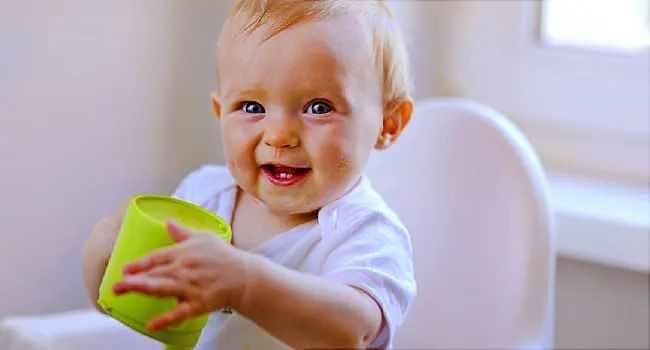Whether you breastfeed, bottle feed, or do a combo of the two, at some point you’ll wonder: Is it time to move on to a cup?
If you just breastfeed, the easiest switch is to skip bottles entirely and go straight to cups around the 1-year mark, or whenever you decide to stop nursing. If your child happily sucks on bottles, their first birthday might still be a good choice. That’s because you’re already changing from formula to cow’s milk around that time.
Missed that window? Waiting until your baby is a little older? No worries, but don’t wait too long. The American Academy of Pediatrics suggests saying bye-bye to the bottle before your baby is 18 months old. “I’d say definitely before age 2, but the sooner the better,” says Keith T. Ayoob, EdD. He’s an associate clinical professor of pediatrics at Albert Einstein College of Medicine in Bronx, N.Y.
As a registered dietitian who works with kids, Ayoob snatches the bottle from kids as old as 5 — and he says it isn’t pretty. “You have to know your child, but in general, the longer you wait the harder it is.”
A bottle gives food and comfort to many children, so letting your little one use it for as long as they like might seem harmless enough. But there are several reasons why it’s smart to switch to cups:
Bottles boost tooth decay. Milk has lactose, a type of sugar. And if you’re giving your child juice in a bottle (though you shouldn’t), that’s even worse. “The acid in juice is a nightmare for teeth,” Ayoob says.
Milk should remain an important part of your child’s diet, and juice is OK now and then. Sucked from a bottle though, the sugar and acid will stay longer on their teeth, which could lead to cavities. Letting a baby go to sleep with a bottle is especially bad, because your body makes less saliva (which helps to wash away food particles) while you’re asleep.
Prolonged use of a bottle is linked to obesity. Research shows that kids who are still using a bottle at age 2 are more likely to be obese by the time they’re almost 6. Ayoob says some kids walk around with a bottle in their mouths all the time, even though they’re eating plenty of solid food. This can result in too many calories.
He says that being too attached to the bottle could have the opposite effect, too: With some picky eaters, the bottle becomes the “go-to meal,” and a child may not be eating enough of his breakfast, lunch, or dinner.
Bottles could mess with her smile. Constant sucking can change the position of her adult teeth down the line. It can affect the development of her facial muscles and palate (roof of her mouth), says Peter Richel, MD. He’s the chief of pediatrics at Northern Westchester Hospital in Mount Kisco, N.Y. This can easily lead to an overbite that might later need to be corrected with orthodontia such as braces.
Drinking while laying down increases the chance of ear infections. If your little one loves to curl up with a bottle, watch out.
“Some of the milk kind of gurgles up in the back of the throat, and it just sort of sits there while bacteria grows,” Ayoob says. “Bacteria can crawl right up the Eustachian tube [in the throat] and into the ear.”
Your child should know how to drink out of a cup before you take away the bottle. Many pediatricians tell parents to introduce sippy cups around 6 to 9 months. That’s when kids commonly start drinking water and other liquids besides formula and breast milk.
If, from a young age, you start giving some milk (not just water) in sippy or regular cups, then things will be easier when you’re ready to get rid of the bottle for good, Richel says.
Once you decide to ditch bottles, there are two main ways to go about it: Go cold turkey, or slowly wean her off. Whichever way you choose, experts agree that sticking to it is key. “Cold turkey is the quickest but most difficult for parents, because they feel they are being cruel,” Richel says.
Just don’t expect either way to be easy. Even if you opt to wean slowly, “there will be some pushback,” Ayoob says. “If you’re trying to do it without any resistance whatsoever, you’re in the wrong business.”
Cold turkey: One day, you simply make all the bottles disappear. If your child is old enough to understand, it might help to include them in the process. For example, you can warn them that today is the last day for bottles, and that starting tomorrow, they are going to drink only from “big boy” cups.
Weaning: The idea is to slowly swap out bottles in favor of cups. For example, you might fill in a cup for the bottle at just one feeding a day, then add a second cup the following week.
No matter how slow (or fast) you want to go, Ayoob says you should take away the mid-day bottles first, then the morning one. Get your child used to eating something solid first thing in the morning, he says, before you remove the morning bottle.
Most experts (and parents!) agree that taking away the nighttime bottle is the toughest final step. “Denying your baby a bottle, especially that last one before bed, can be incredibly challenging for moms and dads,” says Rallie McAllister, MD, MPH, coauthor of The Mommy MD Guide to the Toddler Years. “It makes it far more difficult to get babies to sleep, and when babies don’t sleep, neither do their parents.”
To make things easier, she says to have a bedtime ritual in place. This keeps you from solely relying on the bottle to ease your child into sleep. “A nice warm bath, rocking while reading a story, and snuggling with a lovey can be great sources of comfort, security, and relaxation before bedtime, even when the bedtime bottle is no longer a part of the routine,” she says.
Nervous about stopping the bottle? We asked the experts to offer some extra help and support.
You’re thinking: “She hates sippy cups.”
The fix: To protect her teeth, try a cup that doesn’t have a solid spout. It’s too similar to a nipple, says Ayoob, who says a straw is a better choice. But in the end, “the best sippy cup is the one your child will drink from happily and consistently,” McAllister says. “Buy a few different types and experiment. When you find one your child likes, buy a few!”
You can also have your child use regular, non-sippy cups. Still, it might take some time for her to learn to use it by herself. Give her something thick — like vanilla yogurt or some puréed fruit that’s been thinned with a little water — to cut back on spills, Ayoob says.
You’re thinking: “She’ll drink water or juice from a sippy cup — just not milk.”
The fix: “Some children love the bottle so very much that they will be stubborn to take milk from anything else, but this is a temporary hunger strike!” Richel says.
Not willing to wait it out? Take the nipple off the bottle and offer it with a straw instead. Or start putting water in bottles and milk in cups and give your child a choice. “Tell her, ‘Milk comes in a cup now. Water comes in a bottle. Which one do you want?'” Ayoob says. You can also try to make milk in a cup more tempting by flavoring it with puréed strawberries or other fruit. “A strawberry ‘milkshake’ might tempt her to drink from a cup,” McAllister says.
You’re thinking: “If she refuses the cup, she won’t get enough calcium.”
The fix: Don’t worry about them not getting enough calcium, even if they refuse milk from a cup for several weeks. Just be sure to feed them other sources, such as cheese and yogurt. Broccoli, soy milk, and calcium-fortified orange juice are good picks, too.
You’re thinking: “He’s going to throw a tantrum.”
The fix: Let them. Throwing a fit is hardly out of character for a toddler, and they’ll get over it. “If the parent is willing to put up with a meltdown for a day or two, it will go away,” Ayoob says. “Remember, if he can drink from a cup, you’re not denying him liquid.”
You’re thinking: “She’ll never fall asleep.”
The fix: Many children are used to having a bottle to settle down, but that will change. “Infants and toddlers can learn to self-soothe without the sucking that they have been accustomed to from pacifiers or bottles,” Richel says. “It simply takes a bit of time. But it will happen.”













![Ep265: [Lean Series] 5 Ways You’re F*cking Up Your Fat Loss Ep265: [Lean Series] 5 Ways You’re F*cking Up Your Fat Loss](https://carrotsncake.com/wp-content/uploads/2025/01/IMG_3025-768x1024-1.jpg)






Discussion about this post